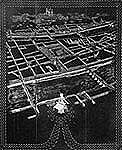
 Pierre Bobot was born on February 16, 1902, in Paris. He was a student at the Bernard Palissy School and entered the National School of Decorative Arts in 1921.
Pierre Bobot was born on February 16, 1902, in Paris. He was a student at the Bernard Palissy School and entered the National School of Decorative Arts in 1921.
For a time, he worked at a restoration workshop for ancient Chinese lacquerware, where he gained knowledge of challenging techniques that captivated his interest and shaped his vocation.
In 1923, he established his own studio. Concurrently, he became a restorer for the National Museums and Palaces, continuing his research and pursuing his personal artistic endeavors.
Since 1932, Pierre Bobot has been exhibiting at the Salons d'Automne, as well as the Salons of Decorative Artists and the National Fine Arts exhibitions. He also participated in the exhibitions in Cairo in 1938 and New York in 1939. At the 1937 Exhibition, he served as a member of the jury for the lacquer category, chaired by Jean Dunand. His works were featured in various presentations by decorative artists, including panels, folding screens, and tables.
Furthermore, Bobot continued to collaborate with Leleu, Dominique, Jallot, Pascaud, and occasionally designed fully lacquered or ornamentally inlaid furniture himself.
He has received the Plumet Prize (Society of Decorative Artists) and the Puvis de Chavannes Prize (National Society of Fine Arts), as well as accolades from the Society for the Encouragement of Arts and Industry. He also received an honorary diploma at the 1937 Exhibition.
Works by Bobot acquired by the City of Paris and the State are displayed at the City Hall, the National Furniture, the Ministry of Reconstruction, and the Tobacco Hotel. He executed the panels presented by the President of the Republic to Queen Juliana, and has undertaken significant projects for French shipping companies and the Dutch liner "Orange."
Pierre Bobot, who has been a professor at the School of Applied Arts since 1934, was appointed as a Knight of the Legion of Honor in the autumn of 1954. After initially working with natural lacquers, Bobot has now predominantly adopted synthetic lacquers that offer comparable aesthetic qualities and durability, while employing similar techniques.
Moreover, these lacquers are harmless in their application, unlike vegetable-based lacquers that emit toxic fumes that only Asians, such as the Japanese or Indochinese, are accustomed to. The new products have thus enabled Bobot to establish a workshop of French artisans.
As a seasoned technician, Pierre Bobot appreciates the inherent beauty of lacquer, revels in the iridescence of gold and silver, and has often revived engraved lacquers reminiscent of ancient Chinese Coromandel lacquers. He achieves intriguing effects by layering two lacquers of different thicknesses, creating a solid background adorned with ornamental motifs, flowers, birds, and even relief-animated scenes.
Above all, he conceives his panels as a pretext for grand decorative compositions, meticulously studying their designs and iconography with exceptional care.
Bobot's work immediately evokes charming panoramic views of Paris, such as the Sainte-Chapelle, Place de la Concorde, or the Carrousel, as well as meticulously crafted harbor plans and architecturally solidified landscapes. Trees and hunting scenes also inspire him, and when the opportunity arises, as seen in the pulpit of the small Romanesque church in Gréville, he seeks to infuse a primitive character that harmonizes with the architectural structure through the rhythm of the figures and the coloring of the lacquers.
As he willingly affirms, the art of lacquer is one of patience, rich in expressive means that are never exhausted and gradually reveal themselves to those who genuinely understand and love the craft.